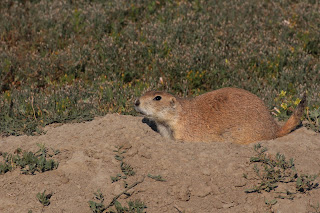52 degrees at 7:20.
We decide to complete the scenic loop this morning and within a few
minutes come across several groups of bison wondering along and across the
road. They don’t seem half as intimidated
by cars as we are by them. Even the
young ones will pause in the middle of
the road until the spirit moves them to amble on.
 |
| Wanna play chicken? |
There are wild horses in this area too, and we watched as
several horses nudged a few young bison away from the spot they are grazing. That brought a quick reaction from a few nearby adult bison and the
horses quickly moved away.
Next we pause to watch the prairie dogs. I sat on a bench about 5 feet from this
little fellow who chirped an alarm every time I moved. I could probably see 25-30 burrows from my bench.
Their chirps sound like a doggie squeeze toy.
The area looks like a moonscape with many craters where their holes are. Some
seem to be in family groups and these two wrestled and carried on.
Moving on down the road, there were many interesting rock
formations. A hard caprock covered some
of the sandstone, protecting it from erosion, which resulted in odd toadstool
like formations called hoo-doos. Various
layers of color added interest too, as well as cannon-ball shaped concretions
embedded in softer rock.
We completed the loop and went to the Visitor’s Center to
watch a film called “Refuge of the American Spirit” about this park and
Theodore Roosevelt. Roosevelt lost both
his wife (in childbirth) and his mother (Typhoid) the same year, and came to
this area where he worked on a ranch while recovering. He returned to New York, remarried and
eventually became president when President McKinley was assassinated (much to
the chagrin of those who elected him vice-president to keep him out of their
hair!) He was later instrumental in preserving this and other areas, as well as
sending 10 of the disappearing bison to the Bronx zoo for breeding. Many of those in the west today are
descendants of those 10.
There is a northern unit of the Park, about 70 miles north
and someone had told us not to miss it, so we headed that direction. It was still early in the day, so we continued
past the park to Fort Union Trading Post which was an important Fort and Fur
Trading Post on the Missouri river (which has since changed course).
A replica of Bourgeois House, built by John Jacob Astor who
founded the American Fur Company, is within the fort. 250,000 buffalo robes and $100,000 in
merchandise traded here annually between 1828 and 1867.
We met a photographer from France, Bruce Soyez Bernard, who
was traveling the country for two months. He did mostly photos of people, with accompanying short stories. He had been to Sturgis and showed us a few of his photos. He has lived in New York for a while, so his English was quite
good. Interesting chat. We’ll check out
his facebook page...and we invited him to come by our house on his return trip via
the South.
There is quite a bit of agriculture in the area, with sugar
beets and wheat being popular. There is
also quite a bit of oil activity the further north we go, with many jack-up rigs pumping away. It wasn’t uncommon to see one or more rigs in
the middle of a wheat or hay field. The
flare-off fire near the rigs is burning off gasses.
There used to be quite a shortage of oil field workers in this area
and many come here in trailers and campers to work for a season or two. Some housing was empty, as we heard that when oil prices fell, many were layed off. But we still saw crowded rv parks and inexpensive
housing units or manufactured homes.
One sign advertised a Summer special rate of
$649 per week for 1 ½ bedrooms. There is
basically nothing in the area and winters are long and brutal so the pay has to be good.
We double-back to the North unit of TRNP and choose campsite
28.
We have mac ‘n’ cheese and ham for dinner, and then take a
ride out the 14 mile road of the park. Much
the same as the south, we see bison, deer and wild turkeys and lots of dramatic
rock formations and overlooks. This one is Riverbend Overlook. We could see a bison and wild horses in the distance.
 |
| Small pavilion built by the CCC at another overlook |
The setting sun was an orange fireball but set over grassy
fields rather than the canyons and spires.
Note: overall, we think a visit to the southern unit would have
been sufficient since we didn’t really see much different in the north.















No comments:
Post a Comment